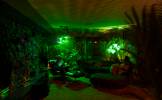Nearby Ruby Mountain country great for summer hiking

With school finally out for summer and a long stretch of hot weather looming, Southern Nevada families have both the time and good reason to seek more distant and cooler climates for hiking or sightseeing. One of the most pleasantly cool summer climates in our state lies in the visually stunning Ruby Mountain country, just east of Elko, about 440 miles from Las Vegas. These mountains get more rain than our southern ranges and are refreshingly green this time of year.
The Ruby Mountains Ranger District, managed by the U.S. Forest Service, encompasses about 450,000 acres that include the East Humboldt Range on the north and the Ruby Mountains Range just a bit southwest. The elevations here range from 6,000 feet up to 11,387 at its highest peak, Ruby Dome.
Its best trails can be found by driving up Lamoille Canyon, a 12-mile paved scenic byway widely acknowledged as one of the most picturesque in Nevada. The road takes you up through a U-shaped valley carved by a long-melted glacier. During summer, the road displays lush spreads of wildflowers, swift-flowing creeks, abundant waterfalls, cascades and ponds.
At the terminus of the drive, called Road’s End, and at an elevation of 8,800 feet, you will be surrounded by the Rubys themselves. Many trails start from here, including a great backpacking route along the Ruby Crest National Recreation Trail. It is a strenuous high-elevation hike of about 34 miles that takes you from Road’s End south along the crest to Harrison Pass. Most hikers spend about four days on this journey.
But a mere day hike from here is extremely satisfying. One that also leaves from Road’s End takes you up to Lamoille Lake. It is about 3½ miles roundtrip with an elevation gain of about 940 feet. Along the way, you will be treated to streams and a couple of other crystal-clear alpine lakes before reaching Lake Lamoille.
Two trails often overlooked leave from other places along Lamoille Canyon. The 1½-mile Nature Trail leaves from the Terraces Picnic Area, and the four-mile roundtrip Thomas Canyon Trail leaves from the Thomas Canyon Campground.
Plenty of wildlife live in these mountains, including Rocky Mountain bighorn sheep, pronghorn, marmot and beaver. There are also Rocky Mountain goats, which were introduced there in the 1960s, and you might even see a Himalayan snowcock, an exotic bird introduced between 1963 and 1979.
Afternoon thunderstorms are common in late summer and fall, so be sure to check the weather before setting out. It is also common to find patches of snow in summer. Nighttime low temperatures can dip into the 30s at these high elevations, so if you backpack, be prepared for any type of weather, including even a rare summer snowstorm.
This region lies a full day’s drive north of Las Vegas, so you’ll need to make some overnight arrangements. If you want to camp, Thomas Canyon Campground is a good choice and is located in Lamoille Canyon. You can reserve a site at recreation.gov/ or call 877-444-6777.
However, if your plan includes over-nighting someplace with restaurants and an indoor bed, nearby Elko is an excellent choice. You can get reservations and further information at elkocva.com. Elko is one of the few American cities where you can enjoy good Basque restaurants, noted for hearty dishes of beef or lamb, served family-style, often preceded or followed by the potent local cocktail, Picon punch. During July 6-8, it’s the site of the National Basque Festival, filling the town with Western families celebrating their Old World roots with traditional costumes, dances, sports, music and food. And on any Saturday night you might see real buckaroos, proudly decorated in turquoise and 10-gallon hats, in town for a short break from the ranch.
Deborah Wall is the author of "Great Hikes, A Cerca Country Guide" and "Base Camp Las Vegas: Hiking the Southwestern States," published by Stephens Press. She can be reached at deborabus@aol.com.


















